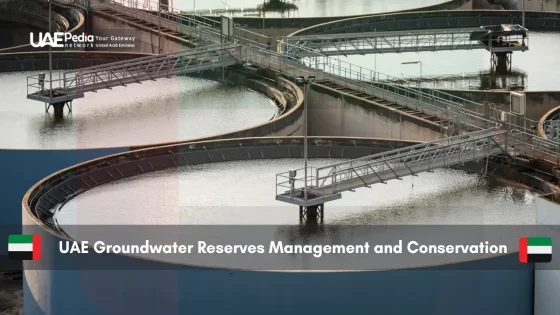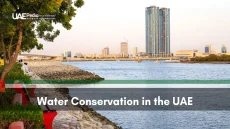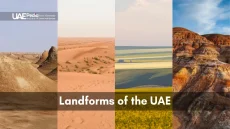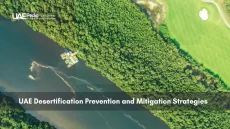What if I told you the desert holds more secrets than sand? Beneath Abu Dhabi’s shimmering skyline lies a finite treasure: ancient aquifers holding water older than the emirate itself. But here’s the twist – these underground reserves are dropping three times faster than nature can replenish them, according to recent Masdar Institute research.
We’re not just talking puddles. These aquifers supply over half the water for date palms – those iconic trees shading souqs and oases. Yet rapid development and climate pressures have turned this lifeline into a ticking clock. Salty intrusions and shrinking levels now push scientists and policymakers into high gear.
The Environment Agency – Abu Dhabi isn’t sitting idle. Through satellite monitoring and smart licensing, they’re mapping every drop like archivists preserving rare manuscripts. Think of it as water banking – treating each gallon like irreplaceable currency in a land where annual rainfall barely fills a coffee cup.
So why should this matter to you? Whether you’re sipping karak in a high-rise or tending a garden villa, groundwater challenges shape daily life here. This isn’t just about pipes and policies – it’s about rewriting survival in a hyper-arid region dreaming of green futures.
- Abu Dhabi’s aquifers function like non-renewable savings accounts
- Innovative tech tracks usage patterns down to the farm level
- Balancing growth with conservation requires every sector’s input
Overview of the Current Groundwater Challenges
Imagine turning on a tap and tasting the ocean. That’s reality for many farms east of Al Ain, where salty wells now outnumber fresh ones 3-to-1. The culprit? Over-pumping has turned lifelines into brine – 79% of tested sources now show salinity levels higher than seawater.
Environmental Impacts and Scarcity
Nature’s water bank isn’t refilling fast enough. Outside the Hajar Mountains’ rocky catchments, rainfall barely moistens the soil before evaporating. Farms guzzle 60% of extracted water through flood irrigation – a method better suited to rainforests than deserts. This thirst creates a domino effect:
- Dwindling aquifers allow seawater to creep inland
- Soil becomes salt-crusted, killing native plants
- Wildlife migrates as ancient oases shrink
| Sector | % Total Consumption | Salinity Impact |
|---|---|---|
| Agriculture | 60% | High |
| Urban | 30% | Moderate |
| Industrial | 10% | Low |
Socio-Economic Implications
Date farmers face tough choices: drill deeper wells or abandon generations-old groves. Meanwhile, urban expansion pushes consumption up 12% annually. “Water isn’t just infrastructure – it’s culture,” notes a Ministry climate report. Traditional falaj channels that once sustained villages now often run dry.
Smart meters and licensing help, but true balance needs every sector’s buy-in. From hoteliers to factory managers, conserving this liquid gold becomes both duty and survival strategy in the United Arab Emirates’ arid embrace.
Evaluating UAE groundwater reserves: Current Status and Data
Picture your favorite swimming pool – now multiply it by 860,000. That’s how much liquid treasure gets pumped from beneath the desert annually, according to Masdar Institute’s latest report. Rain? It barely makes a dent – evaporation claims every drop nature provides.
“We’re withdrawing fossil water like there’s no tomorrow, but the balance sheet doesn’t lie,” warns an EAD hydrologist. “Current rates could drain certain aquifers within decades.”
Let’s break down the liquid ledger:
| Source | Contribution | Key Fact |
|---|---|---|
| Natural sources | 6% | 0.5 cm/year depletion |
| Desalinated | 42% | 3.2 million cubic meters/day |
| Reused wastewater | 52% | Saves 285 billion liters/year |
Agriculture drinks deepest here, slurping 72% through thirsty irrigation channels. Urban areas sip 25%, while industries take modest gulps. The math gets scary when you realize natural recharge equals zero – like refilling a bathtub with an eyedropper while the drain stays open.
Satellite scans now map underground reservoirs with meter-level precision. These high-tech inventories shape national strategies, helping balance immediate needs against long-term survival. Because in this equation, every liter counts twice – once when it’s used, and again when it’s gone.
Government and Regulatory Responses in the United Arab Emirates
Think of water laws as invisible levees – they shape how resources flow through a hyper-arid landscape. Since 2016, strict licensing under the Abu Dhabi Groundwater Law has transformed extraction practices. Farmers now get permits tailored to their crops’ thirst levels and soil types. No more wild west drilling – every well gets tracked like a precious artifact.
Legislative Framework and Licensing
Picture a world where date palms drink by appointment. The 2016 law does just that, setting extraction limits using satellite data and crop algorithms. “We treat each license like a water prescription,” explains an EAD hydrologist. “Overdosing harms everyone.”
| License Type | Key Factor | Impact |
|---|---|---|
| Agricultural | Crop water needs | Reduces waste by 38% |
| Commercial | Site conditions | Prevents salt buildup |
| Residential | Household size | Caps daily use |
Monitoring Initiatives and Groundwater Atlas
Officials didn’t stop at rules – they built a liquid encyclopedia. The ten-volume groundwater atlas maps over 100,000 wells, separating working systems from dry holes. Thermal drones and soil sensors update salinity maps weekly, creating a live dashboard for decision-makers.
This isn’t just paperwork. Real-time data helps balance urban growth with ecological limits. From Al Dhafra’s farms to Abu Dhabi’s suburbs, every drop gets counted twice – once when pumped, and again when managed.
Innovative Scientific Research on Water Budget Analysis
Imagine your phone tracking every drop you drink – that’s essentially what scientists now do for entire regions. A water budget works like a financial ledger, balancing incoming sources (rainfall, desalination) against outflows (evaporation, extraction). Get this equation wrong, and you’re basically overspending nature’s savings account.
Here’s where it gets exciting: Masdar Institute teamed up with NASA’s GRACE satellites to map water movements invisible to the naked eye. Their model tracks rainfall down to the cubic meter while calculating how much vanishes through plant transpiration and desert heat. Think of it as an X-ray for aquifers – revealing hidden patterns in freshwater systems.
When Space Tech Meets Desert Realities
Old well measurements often missed the bigger picture. Now, orbital sensors detect subtle level changes across vast areas. One breakthrough study quantified annual evapotranspiration losses equivalent to 12 billion bathtubs – data that reshaped irrigation policies overnight.
These tools also expose tricky gaps. For instance, treated wastewater reuse now gets counted as a gain rather than a loss. “We’re rewriting the hydration playbook,” says a Masdar researcher. “Every golf course sprinkler and palm grove drip line factors into the math.”
Collaborations between universities and planners turn raw numbers into action. Real-time dashboards help balance urban demand with ecological limits. It’s not just science – it’s survival arithmetic for hyper-arid landscapes dreaming of green futures.
Agricultural Demands and Environmental Pressures
In the heart of the desert, farmers face a modern-day gold rush – but their treasure is liquid. Fields of alfalfa and date palms drink 65% of extracted water resources, creating a delicate dance between food security and ecological limits. Recent data reveals a sobering truth: every liter pumped today could leave future generations parched.
Smart Water Math for Thirsty Crops
Farmers now wield digital tools sharper than traditional shovels. Crop water calculators analyze soil moisture meters, weather patterns, and plant needs down to the milliliter. One Al Ain date farm slashed usage by 40% using these systems – proving tech and tradition can grow together.
| Irrigation Method | Water Saved | Adoption Rate |
|---|---|---|
| Drip Systems | 55% | 68% |
| Soil Sensors | 30% | 42% |
| Calculators | 40% | 29% |
When Wells Turn Sour
Decades of pumping leave bitter traces. In Abu Dhabi’s western region, 58% of wells now exceed safe salinity levels – turning fertile plots into salt-tinged battlegrounds. “We’re not just losing water quality,” notes an agronomist reviewing decade-old samples. “We’re altering the land’s very chemistry.”
The solution? Blending ancient wisdom with innovation. Some farms revive aflaj channels while adopting recycled water for drought-resistant crops. Others pivot to agricultural activities needing less irrigation, like greenhouse herbs. It’s a race against time where every drop’s journey matters – from aquifer to root to future rainfall.
Technological Advances in Groundwater and Water Supply Management
Imagine turning saltwater into sippable streams with a high-tech twist. The emirate abu dhabi now runs the world’s largest reverse-osmosis plant – a maze of filters and pumps producing 200 million cubic meters yearly. That’s enough to fill 80,000 Olympic pools with crystal-clear H2O stripped of ocean minerals.
But here’s the real game-changer: blending desalinated flows with treated wastewater. Advanced recycling plants now purify 90% of sewage into irrigation-grade streams. One project near Al Wathba redirects 44 million cubic meters annually to parks and farms – smart math for a desert region.
When Data Meets Droplets
Real-time sensors track every liter’s journey. The abu dhabi emirate’s central dashboard monitors:
- Pipe pressure fluctuations during peak hours
- Salt levels in desalination output
- Recycled water quality across 12 districts
“We’re not just moving water – we’re orchestrating it,” says a project manager overseeing the Taweelah mega-plant. “Think of it as liquid logistics powered by AI.”
| Technology | Capacity | Efficiency Gain |
|---|---|---|
| Solar Desalination | 150M m³/year | 40% energy saved |
| Smart Irrigation | 850 farms | 55% less waste |
| AI Leak Detection | 11,000 km pipes | 15% loss reduction |
These projects transform how the emirate abu dhabi stewards its most precious resource. From skyscraper cooling systems to date palm groves, every sector benefits. Better yet? The tech slashes groundwater reliance – preserving ancient aquifers for drier years ahead.
Collaboration fuels progress. When regulators share data with tech developers, magic happens. Last year’s hackathon birthed a groundwater-predicting algorithm now used across the abu dhabi emirate. It’s proof that innovation flows fastest when minds merge like tributaries.
Anticipating Future Challenges for Water Sustainability
Envision a future where every raindrop gets multiple lives. The emirate of Abu Dhabi isn’t waiting for crises – its Environment Agency (EAD) launched a three-year mission to map deep aquifers using AI and seismic tech. Think of it as underground cartography, charting liquid pathways older than the desert itself.
When Data Shapes Tomorrow’s Drops
“We’re not just measuring scarcity – we’re redesigning resilience,” shares an EAD project lead. Their latest models predict a 22% demand surge by 2040, driven by urban growth and hotter climates. Three game-changers emerge:
- Retrofitting desalination plants to produce 50% more cubic meters using solar energy
- Creating underground storage banks capable of holding 6 billion liters
- Training AI to pinpoint recharge zones where treated wastewater can replenish sources
The Abu Dhabi emirate’s water budget now factors in evaporation rates and soil absorption down to the square kilometer. Farmers receive monthly updates on optimal irrigation times, while developers access real-time aquifer health maps before breaking ground.
Collaborations between the environment agency and tech startups yield surprising wins. One pilot project near Al Ain uses graphene filters to slash desalination costs by 30%. Another tests cloud-seeding drones that could squeeze extra rainfall from thin air – literally.
Future-proofing liquid security means treating data as currency. Every sensor reading and satellite scan gets fed into adaptive models that steer policy. It’s less about predicting the future than building systems flexible enough to thrive in whatever climate comes next.
Final Reflections and the Way Forward for UAE Water Conservation
Imagine passing a water bottle to your grandchild, only to find it half-empty – that’s the reality we’re working to change. The journey ahead demands balancing thirsty crops with shrinking wells, urban growth with ancient ecosystems. But here’s the good news: solutions are flowing faster than ever.
Farmers face tough choices as decades of pumping strain ancient wells. Urban growth pushes demand higher each year. Yet hope flows through smart solutions – from laws limiting extraction to AI-powered sensors tracking every liter. Blending desalinated seawater with treated wastewater creates new loops in the hydration cycle, while efficient irrigation methods slash waste.
This isn’t just about pipes and policies. It’s a cultural pact – choosing to value each drop as both lifeline and legacy. Communities, researchers, and leaders must collaborate like tributaries merging into a river. Want to help? Support farms using recycled water, learn about underground storage projects, and rethink daily habits.
Continuous monitoring and public awareness keep progress on course. Every sensor reading, every conserved gallon, writes a new chapter in this story. Because in arid lands, water security isn’t just science – it’s shared survival. Let’s ensure that bottle gets passed forward, full.
With desert covering most of the emirate, natural freshwater sources are limited. Over-pumping for agriculture and urban growth has caused saltwater intrusion in some areas. The government now tracks usage with smart meters and promotes treated wastewater for irrigation to reduce strain on underground reserves.
Desalinated seawater provides 42% of Abu Dhabi’s drinking supply—but it’s energy-intensive. New solar-powered plants and blending desalinated water with treated wastewater (like the Al Wathba facility does) help balance demand. Still, conservation remains key to long-term sustainability.
All wells require permits from the Environment Agency. Licenses specify pumping limits based on aquifer health and crop needs. Drones and satellite moisture sensors now monitor farms to prevent over-extraction. Some areas even get free soil sensors to optimize irrigation schedules!
Think of it as Google Maps for aquifers! This digital tool by the Ministry of Climate Change shows real-time depth, quality, and recharge rates across all seven emirates. It helps planners allocate water smarter—like prioritizing which date palm farms get subsidies for drip irrigation upgrades.
Yes—but incentives work better. Households using 30% less than their neighborhood average earn tariff discounts. Overusers pay higher rates, with fines for leaks left unfixed. Pro tip: Look for the “Waterwise” label when buying showerheads or AC units—they slash usage without sacrificing comfort.
From cloud-seeding drones to AI predicting reservoir levels, the UAE loves innovation. The Masdar Institute’s “solar dome” desalination pilot cuts energy use by 50%. Meanwhile, LiDAR scans uncover ancient fossil aquifers—secret underground stores that could buffer droughts if managed wisely.


















